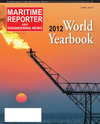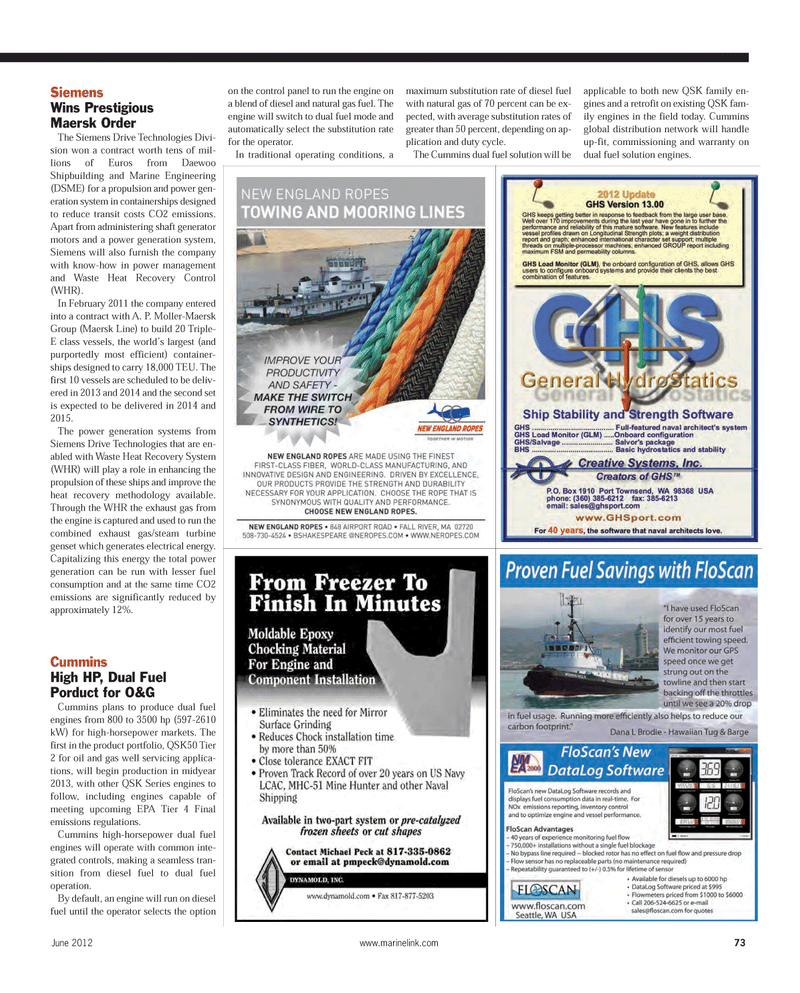
Page 73: of Maritime Reporter Magazine (June 2012)
Annual World Yearbook
Read this page in Pdf, Flash or Html5 edition of June 2012 Maritime Reporter Magazine
SiemensWins Prestigious Maersk OrderThe Siemens Drive Technologies Divi- sion won a contract worth tens of mil- lions of Euros from Daewoo Shipbuilding and Marine Engineering (DSME) for a propulsion and power gen- eration system in containerships designedto reduce transit costs CO2 emissions.Apart from administering shaft generatormotors and a power generation system, Siemens will also furnish the company with know-how in power management and Waste Heat Recovery Control (WHR). In February 2011 the company entered into a contract with A. P. Moller-Maersk Group (Maersk Line) to build 20 Triple- E class vessels, the world?s largest (and purportedly most efficient) container- ships designed to carry 18,000 TEU. The first 10 vessels are scheduled to be deliv- ered in 2013 and 2014 and the second setis expected to be delivered in 2014 and 2015.The power generation systems from Siemens Drive Technologies that are en- abled with Waste Heat Recovery System (WHR) will play a role in enhancing thepropulsion of these ships and improve the heat recovery methodology available. Through the WHR the exhaust gas from the engine is captured and used to run thecombined exhaust gas/steam turbine genset which generates electrical energy. Capitalizing this energy the total power generation can be run with lesser fuelconsumption and at the same time CO2emissions are significantly reduced by approximately 12%.Cummins High HP, Dual Fuel Porduct for O&GCummins plans to produce dual fuelengines from 800 to 3500 hp (597-2610kW) for high-horsepower markets. The first in the product portfolio, QSK50 Tier 2 for oil and gas well servicing applica- tions, will begin production in midyear 2013, with other QSK Series engines tofollow, including engines capable of meeting upcoming EPA Tier 4 Final emissions regulations. Cummins high-horsepower dual fuel engines will operate with common inte-grated controls, making a seamless tran-sition from diesel fuel to dual fueloperation. By default, an engine will run on diesel fuel until the operator selects the optionon the control panel to run the engine ona blend of diesel and natural gas fuel. The engine will switch to dual fuel mode andautomatically select the substitution ratefor the operator. In traditional operating conditions, amaximum substitution rate of diesel fuelwith natural gas of 70 percent can be ex- pected, with average substitution rates of greater than 50 percent, depending on ap-plication and duty cycle. The Cummins dual fuel solution will beapplicable to both new QSK family en- gines and a retrofit on existing QSK fam- ily engines in the field today. Cummins global distribution network will handle up-fit, commissioning and warranty on dual fuel solution engines. June 2012www.marinelink.com 73MR June12 # 9 (65-73):MR Template 6/12/2012 3:30 PM Page 73

 72
72

 74
74
